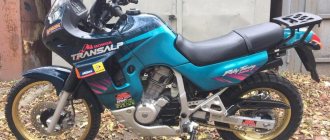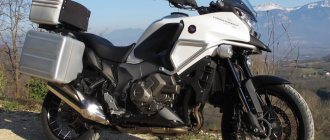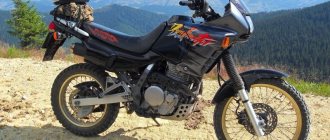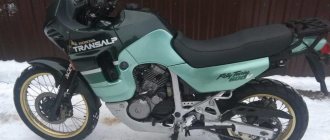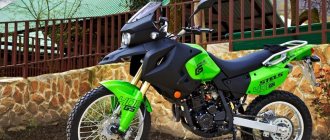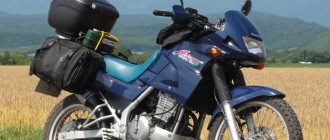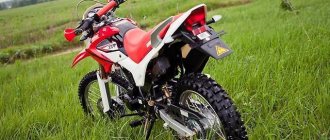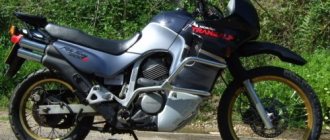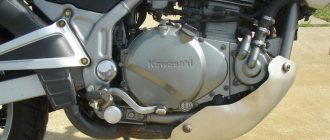Japanese motorcyclesHonda motorcycles
The XL650V Transalp enduro touring bike was produced by the Japanese company Honda between 2000 and 2008.
Having replaced its predecessor XL600V in the line of the famous brand, the Honda Transalp 650 motorcycle created a real sensation among fans.
What is unique about the model? Let's figure it out.
Bike features
Here are the main features of the Honda XL 650 V Transalp:
- the gas tank is significantly larger in volume than average;
- new, more stylish design (compared to the 600th model);
- presence of an alarm button.
All this and some other points make the motorcycle one of the best representatives of modern enduro for touring. However, the bike is also well suited for the city, except that buying such a motorcycle just for riding on the streets is not practical.
Photo gallery
If you are a born traveler, and your life is dear, then you need to look for a universal iron horse that will be ready to go any route. As we have already found out, the Honda Transalp 650 motorcycle is a good option for this; you can see its external data in our small selection.
Engine
The motor of this Transalp is not a unique development for a specific model. It was derived from a Honda Deauville 650, a pretty serious touring bike. This is a V-type unit, it is four-stroke and two-cylinder. Its displacement reaches 647 cm³, and its compression ratio is 9.2:1. The engine receives liquid cooling. Each cylinder has 3 valves, which was also typical for its predecessor. The fuel supply system is carburetor.
Torque at its peak at 5500 rpm is 56 Nm, while power at its maximum at 7500 reaches 55 hp. Peak speed for a motorcycle is 172 km/h. The XL 650 V accelerates to 100 km/h in just 5.1 seconds, which is quite respectable for a touring enduro of impressive dimensions.
Review of the Honda XL 700 V Transalp motorcycle
My unpretentious rogue, namely Honda Transalp XL700VA, 2012. which has brought me mixed feelings and emotions for more than one season now.
I have long wanted this particular model; before that I rode a Honda CB400 and a 250 cc Chinese maxi-scooter. Many will say that the 700 is not the same, they say it weighs a lot and the front wheel is small and the ABS cannot be switched off, but I still like its on-road/off-road ratio, because on asphalt it goes better than the same 600, and on such off-road conditions where the weight of the motorcycle plays a critical role, I only get there a couple of times during the whole season, so for me it was the most suitable option, and besides, I really like it appearance!
A very soft and short stroke of the clutch lever, which grabs, as expected, smoothly and predictably, a large steering angle makes controlling the motorcycle simple and accessible, like a programming textbook for blondes. Although I would replace the steering wheel with a tuning one: the standard one looks flimsy and, for my taste, too wide. And it was apparently made with the last of the money from recycled beer cans - it looks unsightly. However, this does not prevent the motorcycle from turning around easily and naturally on a single-lane road. The engine really pulls well: while slowly but surely I was climbing the Transalp along a mountain path, I noticed that even 2000 rpm is enough to crawl confidently. Although “crawling” is not exactly the same thing, it is still “driving”: the gearbox ratios are such that it will not be possible to move very slowly, like, say, on a Yamaha Serrow. On some sections where only a snail's speed is needed, the Transalp strove to rush forward... You say, I'm being picky - the XL700 was not created for mountaineering, but for traveling on bad, but still roads. But let's face it: wherever it takes us if you sit on an endurance bike...
The bike is excellent and can go on slight off-road terrain. But still, at its core, the Transalp is a road bike that can be used to travel long distances.
I’m sharing my impressions of using this model over a distance of 200 kilometers. It is clearly designed for driving on asphalt: 19x17-inch wheels and a lot of weight. It’s better not to try it off-road; soft soil or sand are not his element. If you do take a risk, check the tow truck’s phone number in advance, since you are unlikely to be able to get out yourself. The front and rear suspensions are poorly adjustable, but they are sufficient for driving on asphalt roads.
The V-cylinder engine is reliable, simple and safe, no complaints here. Wind protection is at the level, if you drive long distances, it definitely needs to be fine-tuned.
I have ridden two motorcycles of this model, since two of my friends are owners of these units. If you listen to their reviews, you simply cannot find better bikes. Over the 200 km that I drove, I would have argued strongly with them. I’m a guy of considerable size: height 183, weight about a hundred, and I wasn’t entirely comfortable in the saddle after just 30 minutes of riding, I don’t understand how you can ride it over long distances, it’s clearly designed for average height. But there’s one more nuance here, one of my friends is short and weighs about 70 kg, so I don’t even understand how he can lift it after falling. It is really very heavy, I made significant efforts to lift it. I have only one option - it hasn’t fallen yet.
Fuel consumption is high, at a speed of 130 km/h, it consumes over 7 liters of fuel.
In total we get:
Pros: good, reliable engine.
Cons: heavy weight, high gas mileage, high cost, suspension.
I wouldn’t buy it for myself; I’m more inclined towards the TA-650.
Dimensions and weight
The weight of the motorcycle is significant: for a fully fueled bike it is as much as 212 kg. The seat height is 843 mm, so for short people this option will be a little more comfortable than the XL 600 V. The wheelbase dimensions are 1505 mm. The motorcycle itself is very tall – as much as 1315 mm. The length and width are also quite large: 2260 mm and 920 mm, respectively.
The fuel tank capacity of the XL 650 V is 19.6 liters. Of these, 3.5 liters are reserve. This is a significant volume, allowing you to travel many kilometers without constantly thinking about the nearest gas station. Gasoline consumption per 100 km of road is relatively low and amounts to only 5.2 liters.
Brief history of the model:
2008 - start of production of the Honda XL700V Transalp model. Model code - RD13. Manufactured in Spain. Model: Honda XL700V Transalp (Europe). Frame number: VTMRD13A08E8E000001 - VTMRD13A08E8E009999. Factory designation: XL700V8, XL700VA8 (ABS).
2009 - no significant changes. Model: Honda XL700V Transalp (Europe). Frame number: VTMRD13A09E9E000001 - VTMRD13A09E9E009999. Factory designation: XL700V9, XL700VA9 (ABS).
2010 - model code RD15. Production moves to Italy. Model: Honda XL700V Transalp (Europe). Frame number: RD15. Factory designation: XL700VA, XL700VAA (ABS).
2011 is the last year of production of the Honda XL700V Transalp model. Model: Honda XL700V Transalp (Europe). Frame number: RD15. Factory designation: XL700VAB.
Chassis and brakes
The bike is equipped with a steel half-duplex frame. It looks impressive, which cannot be said about many other touring enduros. The stylish colors correspond to the purpose of the motorcycle, but do not make its appearance too pretentious. The wheels are spoked, and the steering wheel, in addition to being comfortable and made of steel, also has protection for the driver’s fingers.
The rear suspension is a pendulum version with a monoshock absorber. Its stroke is 187 mm. The front suspension is a telescopic fork with a travel of 200 mm. Its dimensions are 41 mm. The brakes at the rear are a 240 mm disc with a single-piston caliper, while at the front there are two discs, each 256 mm, and the calipers are two-piston.
Tire selection
By default, Transalpas are equipped with a rear wheel measuring 130/80–17, but installing tires from “Goose”, which is only 1 cm wider (140/80–17), will not affect handling at all, but increases the tire life by 25 percent -thirty. For primarily road use with rare trips to graders and dry primers, tires of the previous generation are suitable - Metzeler Tourance, Michelin Anakee 2, Conti Escape. They will more or less provide grip on any surface and will last a long time. If you rarely leave the asphalt, then it is better to choose modern models Tourance Next, Anakee 3, Pirelli Scorpion Trail 2, Continental Trail Attack 2. They keep the asphalt at the level of sports-touring tires on road motorcycles, but this is achieved at the expense of off-road qualities.
These motorcycles are used less often for off-roading than their “bigger” brothers, however, toothy tires can be found. Human-tested options would be the Conti TKC-80 Twinduro, Metzeler Karoo-3, Michelin Anakee Wild, Pirelli Scorpion Rally.
Don't turn your nose up at second-tier manufacturers. For example, the Shinko E705 has proven itself to be excellent for asphalt and light off-road use, while the more toothy E804–805 is suitable for serious off-road use. They both have a reasonable price, long life and good grip properties, and the money saved can be invested in wind protection and heated grips - this will be more useful on a long journey.
Tires for both the Transalp and the F 650/700 GS can always be found in stock without any problems - the sizes are standard, there is no shortage, there is always plenty to choose from.
www.motorezina.ru
Spices for internal combustion engines. Part 2 > July 22, 2021 07:28 Mikhail Pimus
Tuning
The entire range of accessories and additional components for the Transalp revolves around enhancing the touring and off-road potential of the motorcycle. The list of parts is impressive - from all kinds of luggage cases and windshields to protective bars, additional lights, heating and navigators. Everything in general has a positive effect on consumer characteristics and, what is important, practically does not impair service life and reliability.
Typical disadvantages
Transalp does not have the typical disadvantages. The only service campaign for the "700" was announced in 2008. It touched the ring in which the piston of the rear master cylinder was mounted - it happened that during braking it did not return to its original position and, as a result, the pads rubbing against the disc overheated it. The defective items were replaced under warranty and the problem was resolved.
On the Internet I came across information about problems with radiator fans, front suspensions and spark plugs that are sensitive to moisture. Although these were isolated cases.
As for previous versions, in the “600”, from the very first years of production, ignition modules were installed under the seat. Their forks were positioned in such a way that the movement of the sofa would damage them over time, and the motor would stop supplying a spark to one of the cylinders. The recipe here is horizontal mounting of modules.
In turn, “650” discovered a problem with the radiator wires and, as part of a service campaign in 2002, corrected their fastening. Both versions suffered from a plastic speedometer that wore out rather quickly, which failed at high mileage.
